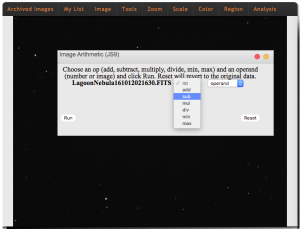Overview
Image calibration refers to the process of removing artifacts from your data that are due strictly to the imaging system used, in this case assumed to be a telescope and CCD camera. Calibration must usually be completed before you can perform any science analysis with the images. There are three parts to image calibration:
- Obtain the calibration images
- Process the calibration images
- Apply the calibration corrections to the science images
Calibrating Your Images
Image calibration consists of removing effects due to variations in pixel sensitivity, bias and dark counts from your images. This process has three steps, outlined below.
- Bias Subtraction – The chip bias is an innate background in your chip which shows up in all images. You want to remove this because it artificially elevates the counts in every pixel, whether exposed to light or not. This is what your zero-second dark exposure images are for… your bias images. The bias will vary from chip to chip, and even from night to night. Typically the bias level is around 1500 ADU. Subtract the master bias from each of the other calibration and science images in turn. After the bias is removed, most CCD detectors will require the dark counts to be subtracted. That is the next step.
- Dark Subtraction – Unless your camera is cryogenically cooled (typically such cameras sit in a dewar filled with liquid nitrogen) you will have to apply a dark subtraction. From your dark images you can see that even in zero light conditions, counts accumulate over time. This rate of count accumulation varies with time and temperature, and will vary from detector to detector. Usually the accumulation of dark counts is linear with time, though for very long exposures this ceases to be true. Usually you can scale a dark exposure downward (never upward) to match the exposure length of the science image you are correcting: Just multiply the master dark by the ratio of the science image exposure time to the exposure time of the dark. You will have to do this for each exposure time in your science images, making a scaled dark for each. If you are doing these operations manually, or with software you have written yourself, you should copy the dark to a temporary file, and then use that file for the scaling and subtraction. That way you will not lose your master dark file. Astronomical software packages all do this for you, so you will not have to worry about this step if you use one of those. Of course, you can also take a set of dark exposures for each set of science images, matching the exposures of each while at the telescope. In any case, once you have a dark image that matches the exposure of each science image, subtract the darks from the corresponding science images, thus removing the dark count contribution from your science images. Now all that is left are the flat corrections.
- Flat Correction – Each pixel in a CCD acts like a nearly independent light detector. As such, the chip can exhibit slight variations in sensitivity from one pixel to the next. This causes brightness variations across the image. In addition, defects or obstructions in the optical path can cause illumination fluctuations on the chip. This is the source of the infamous “dust donuts” seen on uncalibrated CCD images. Flat fielding corrects the image to a “flat” sensitivity… one that does not vary from pixel to pixel. To do this, take your bias and dark subtracted flat fields and compute the mode of the pixel values for each of them (some people prefer to use the median). Divide each flat field by its mode, creating a new normalized flat. Now divide your processed science images by this normalized flat. This procedure will lower artificially high pixels and raise artificially low ones, “correcting” them all to a uniform sensitivity level.
Until you have completed all the steps above you might want to work with copies of your raw science images. That way, if something goes wrong along the way you will have your original files to fall back on. Once you have successfully completed all the calibration steps you can discard your raw images to save space (they are presumably still available somewhere, but you will not need them for subsequent reductions). When you have completed all the calibration steps above, you must (typically) combine your science images… you should take multiple exposures of each target in whatever filters you will use so that cosmic rays can be easily removed, just as was done for your calibration images. If you do not have multiple images of each target you can skip the steps about stacking your science images.
Additional Resources
Image Capture Resource
- To learn how these images are used with your science images see the pages on data reductions.
Dome Flats Resource
- To understand why it might be desirable to obtain dome flights, see the Observing Strategies page).
Resource for Capturing Bias Fields
- See the Observing Strategies page for an explanation of why you should take an odd number of bias images.





